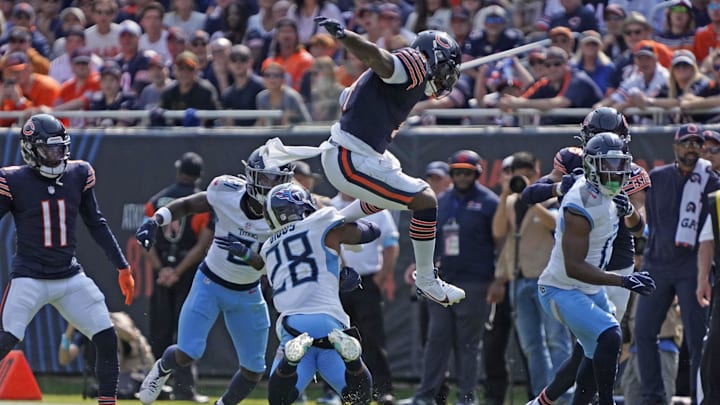Bears Offense Defense Is Shaky Under Matt Eberflus
From the play reps for Cole Kmet to only 14 carries by running backs and 80 total rushing yards, the Bears offense left a great deal to defend and their coach made the attempt.

Considering how far down into a hole the Bears fell on offense to start the season, they seem awfully reluctant to define the reasons 148 total yards happened.
They handed the ball to running backs 14 times for 44 yards, had starting in-line tight end Cole Kmet on the field for only 27 of the 56 offensive plays, and he’s the tight end more involved in blocking the run.
Yet, Matt Eberflus’ take on the running game is virtually that there is nothing wrong.
“You can decipher stats and move those things how you want them,” Eberflus said. “We really feel that we were solid there. We had some negative runs, the 19-yard sack and all those things that take away from the true number. The number is the number and that’s the way I live.
“I thought the efficiency was solid. We’ve had better efficiency in the past and we’re looking forward to getting that this week.”
The 19-yard sack does not come out of the running game totals in pro football. It comes out of your net passing.
And if their efficiency was better in the past but they’re looking forward to getting that this week, then how is it that last week’s total was “solid?”
The 80 total rushing yards with 36 coming from quarterback Caleb Williams or receivers moves the Bears offense out of the physical category and into one absorbing punishment.
Of course, they don’t want to be too run-oriented because then they’d look like Luke Getsy’s run-heavy attack, the one that had fewer pass attempts in 2022 than any NFL team since the 2004 Pittsburgh Steelers.
Yet, they gained only 148 total yards of offense, the lowest total since Matt Nagy’s offense had 47 yards against the Browns in Justin Fields’ 2021 starting debut.
As for Kmet’s limited play total, Eberflus admitted it wasn’t desirable.
“Oversight, not part of the plan, I don’t know about all that,” he said. “I would say that it’s situational.
“We had 11-personnel where he was in, and then when G (Gerald Everett) was in, so it was the way the rotation happened,” Eberflus said.
Everett was in 34 plays as the move-tight end.
“Do we want to get Cole involved in the game plan more in terms of catches and point of attack blocking and all those things? Yes, we do,” Eberflus said. “We’re looking for our formula for success on offense. That’s going to take a little bit of time in terms of distributing the ball to the skill more evenly. We’re working to do that this week.”
Eberflus actually did finally admit to the need for more running game production when he was asked about the offensive line.
“I think that we want better run numbers,” Eberflus said.
The offensive line figures in prominently, and he admitted the pass protection wasn’t consistent.
In the end, he was defending the offense by relying on an old Lovie Smith adage.
“Again, it was Week 1 and the biggest improvement from Week 1 to Week 2 is probably the biggest improvement that you have,” Eberflus said.
The problem with this, of course, is the same one that Smith never explained.
If every team improves the most from Week 1 to Week 2, how does your team, and in this case this offense, gain any ground on anyone?











